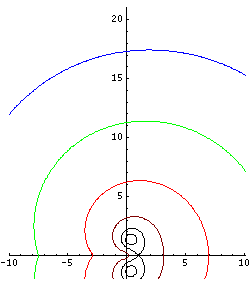Fixed point: Difference between revisions
Jump to navigation
Jump to search
imported>Dmitrii Kouznetsov m (→Operators: grammar) |
imported>Dmitrii Kouznetsov |
||
| Line 32: | Line 32: | ||
==Fixed points of [[exponential]] and fixed points of [[logarithm]]== | ==Fixed points of [[exponential]] and fixed points of [[logarithm]]== | ||
[[Image:FixedPointsLoge00.png|400px|right|thumb|Graphical search for fixed points of logarithm. Function <math>f=|z-\ln(z)|</math> is shown with levels | |||
<math>f=0.25</math>, | |||
<math>f=0.5</math>, | |||
<math>f=1</math>, | |||
<math>f=2</math>, | |||
<math>f=4</math>, | |||
<math>f=8</math>, | |||
<math>f=16</math> | |||
in the complex <math>z</math>-plane | |||
]] | |||
[[Image:FixedPointsExpe00.png]] | |||
==Notes== | ==Notes== | ||
<references/> | <references/> | ||
Revision as of 03:14, 31 May 2008
Fixed point of a functor is solution of equation
- (1)
Simple examples
Elementary functions
In particular, functor can be elementaty function. For example, 0 and 1 are fixed points of function sqrt, because and .
In similar way, 0 is fixed point of sine function, because .
Operators
Functor in the equation (1) can be a linear operator. In this case, the fixed point of functor is its eigenfunction with eigenvalue equal to unity.
Exponential if fixed point or operator of differentiation D, because
- (2) , reals
is fixed point of the Fourier operator, defined with its action on a function :
- (3)
in general, functors have no need to be linear, so, there is no associativity at application of several functors in row, and parenthesis are necessary in the left hand side of eapression (3). [1]
Fixed points of exponential and fixed points of logarithm
Notes
- ↑ Note that that there is certain ambiguity in commonly used writing of mathematical formulas, omiting sign * of multiplication; in equation (3), expression does not mean that is multiplied to value of ; it means that result of action of operator on function , whith is also function, is evaluated at argument .


![{\displaystyle F[L]=L}](https://wikimedia.org/api/rest_v1/media/math/render/svg/952aaf5e42e45721926eb1deb75cdc9613a87971)




















